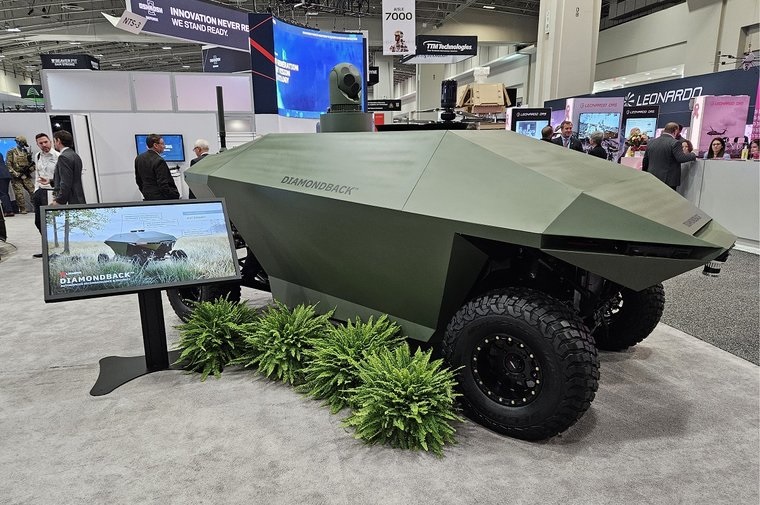L3Harris Unveils 'Diamondback' Autonomous Ground Vehicle Prototype at AUSA 2024

L3Harris has introduced its latest innovation in autonomous military technology with the debut of the “Diamondback” autonomous ground vehicle prototype at the AUSA 2024 event, held from October 14 to 16. This cutting-edge unmanned ground vehicle (UGV) is the result of a collaboration between L3Harris and Overland AI, a company specializing in autonomous ground mobility. Together, they have developed a system that could change how the military navigates and operates in challenging environments.
The Diamondback is equipped with the CrossCountry Autonomy System, a sophisticated platform that enables the vehicle to operate independently in off-road conditions and unpredictable terrain. In modern military scenarios, where risks to personnel are high, this capability is invaluable. The vehicle is designed specifically to address manpower shortages and the increasing demand for safer operations, where sending in troops might otherwise pose significant risks.
### A Game-Changer in Military Autonomy
Ed Zoiss, president of L3Harris Space and Airborne Systems, emphasized that the Diamondback represents a shift in the company’s mission autonomy capabilities. “We are expanding our platform and mission system autonomy capabilities, from air and sea, to support robotic vehicles making first contact with threats in land environments,” he stated. This vision aligns with the growing trend in modern militaries to rely more on autonomous systems in high-risk situations, limiting human exposure to danger.
One of the most remarkable aspects of the Diamondback is its modular design. The vehicle features an open, scalable system that allows for the rapid integration of new technologies. This flexibility makes it highly adaptable to evolving military needs, allowing it to take on a variety of missions, from electronic warfare and reconnaissance to the deployment of autonomous drones. L3Harris has built the Diamondback with future threats in mind, ensuring it remains relevant as military technology and strategies continue to evolve.
### Capabilities and Specifications
Although it wasn’t developed with a specific U.S. Army program in mind, the Diamondback is intended to fill operational gaps, particularly in reconnaissance and security roles. These tasks are often performed in areas where high attrition rates and manpower shortages are prevalent, making autonomous vehicles a critical solution.
The Diamondback is not just another autonomous vehicle; it is designed to complement existing robotic platforms such as the U.S. Army’s Robotic Combat Vehicle (RCV) and Squad Multipurpose Equipment Transport (SMET). It can work in tandem with these systems to enhance battlefield effectiveness, offering greater flexibility and versatility in mission planning.
One of the key features of the Diamondback is its drone launch and retrieval system, located on the vehicle’s roof. This system allows it to deploy drones autonomously, adding a layer of aerial surveillance to its already impressive ground capabilities. This feature, combined with the vehicle's advanced MX-10 RSTA (Reconnaissance, Surveillance, and Target Acquisition) modular sighting system, makes it highly effective in surveillance missions. The MX-10 provides high-resolution imaging, helping the vehicle detect and respond to potential threats.
Additionally, the Diamondback is fitted with the Amorphous system, which allows for multi-domain autonomy control, further enhancing its operational capabilities. The vehicle also has an anti-jam Positioning, Navigation, and Timing (PNT) system, a critical feature in contested environments where GPS signals can be disrupted.
### A Future-Ready Prototype
Though still in the prototype phase, the Diamondback has been designed with the future of warfare in mind. L3Harris intends to conduct demonstrations throughout the spring and summer of 2025 to gather user feedback and refine the vehicle further. According to Hugh McFadden, Director at L3Harris, the goal is to have an initial version of the Diamondback ready for production by the end of 2025.
The modularity and adaptability of the Diamondback ensure that it will not only meet the needs of today's military but also remain relevant in future conflicts. As autonomous systems continue to play an increasingly prominent role in military operations, vehicles like the Diamondback represent the next step in creating safer, more efficient ways to address threats.
In short, the Diamondback is a promising addition to the growing field of autonomous military vehicles, showcasing L3Harris’ commitment to pushing the boundaries of innovation in defense technology.


